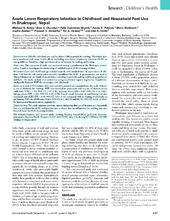Acute Lower Respiratory Infection in Childhood and Household Fuel Use in Bhaktapur, Nepal
Bates, Michael N.; Chandyo, Ram Krishna; Valentiner-Branth, Palle; Pokhrel, Amod K.; Mathisen, Maria; Basnet, Sudha; Shrestha, Prakash S.; Strand, Tor A.; Smith, Kirk R.
Peer reviewed, Journal article
Published version

Åpne
Permanent lenke
https://hdl.handle.net/1956/12155Utgivelsesdato
2013-05Metadata
Vis full innførselSamlinger
Originalversjon
https://doi.org/10.1289/ehp.1205491Sammendrag
Background: Globally, solid fuels are used by about 3 billion people for cooking. These fuels have been associated with many health effects, including acute lower respiratory infection (ALRI) in young children. Nepal has a high prevalence of use of biomass for cooking and heating. Objective: This case–control study was conducted among a population in the Bhaktapur municipality, Nepal, to investigate the relationship of cookfuel type to ALRI in young children. Methods: Cases with ALRI and age-matched controls were enrolled from an open cohort of children 2–35 months old, under active monthly surveillance for ALRI. A questionnaire was used to obtain information on family characteristics, including household cooking and heating appliances and fuels. The main analysis was carried out using conditional logistic regression. Population-attributable fractions (PAF) for stove types were calculated. Results: A total of 917 children (452 cases and 465 controls) were recruited into the study. Relative to use of electricity for cooking, ALRI was increased in association with any use of biomass stoves [odds ratio (OR) = 1.93; 95% CI: 1.24, 2.98], kerosene stoves (OR = 1.87; 95% CI: 1.24, 2.83), and gas stoves (OR = 1.62; 95% CI: 1.05, 2.50). Use of wood, kerosene, or coal heating was also associated with ALRI (OR = 1.45; 95% CI: 0.97, 2.14), compared with no heating or electricity or gas heating. PAFs for ALRI were 18.0% (95% CI: 8.1, 26.9%) and 18.7% (95% CI: 8.4%–27.8%), for biomass and kerosene stoves, respectively. Conclusions: The study supports previous reports indicating that use of biomass as a household fuel is a risk factor for ALRI, and provides new evidence that use of kerosene for cooking may also be a risk factor for ALRI in young children.